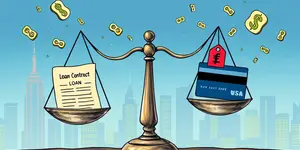
When unexpected expenses arise—whether a medical bill, car repair, or urgent home improvement—you need access to funds quickly. Securing traditional loans often means pledging your assets and waiting weeks for approval. But what if you could get the cash you need without risking your property?
Unsecured loans offer a practical solution that removes the burden of collateral while still providing swift funding. In this article, we explore everything you need to know about unsecured loans, from definitions and comparisons to tips for finding the best rates and managing your debt responsibly.
Unsecured loans are credit products that do not require collateral from borrowers. Instead of seizing your home or car, lenders evaluate your financial profile—credit score, income, credit history, and debt-to-income ratio—to determine eligibility.
This reliance on reputation rather than assets means interest rates are typically higher than secured loans. But the trade-off is significant: you enjoy no collateral requirement means freedom and avoid the risk of losing personal property if you encounter repayment difficulties.
Understanding the differences between unsecured and secured loans helps you choose the right product for your needs. Below is a concise comparison table that highlights key features:
This table underscores why unsecured loans are ideal for flexible, short-term borrowing, while secured options suit large, purpose-driven expenses such as home financing.
Choosing an unsecured loan brings several benefits:
While unsecured loans offer appealing benefits, you must weigh potential downsides:
Defaulting on an unsecured loan can have serious consequences. Lenders may send your debt to collections, file legal claims, or even garnish your wages. Always factor total costs, including fees, and ensure you borrow only what you can repay.
The application process for unsecured loans is designed for speed and simplicity. Here’s what you generally need to prepare:
1. Valid identification and Social Security number.
2. Proof of steady income—pay stubs, tax returns, or bank statements.
3. Employment details and length of service.
4. Your credit score and existing debt obligations.
Most online lenders use automated systems to review your information, often giving approvals within 24 to 48 hours. If you meet their criteria, you could see money deposited into your bank account by the next business day.
The fintech revolution is transforming unsecured loan markets. Alternative data—such as utility bills, rental history, and online activity—enables lenders to extend credit to those with limited traditional credit histories.
Peer-to-peer and marketplace platforms reduce intermediation costs, often passing savings to borrowers. Advanced analytics streamline underwriting, making loan offers faster and more personalized than ever before.
Unsecured loans offer a powerful way to unlock cash swiftly, without pledging assets. By understanding rates, fees, and lender requirements, you can harness these tools to navigate life’s unpredictable financial turns.
Whether consolidating high-interest debt, covering emergency expenses, or funding a special project, unsecured loans put you in control. With careful planning and responsible borrowing, you can secure the funds you need and protect your financial future.
References













